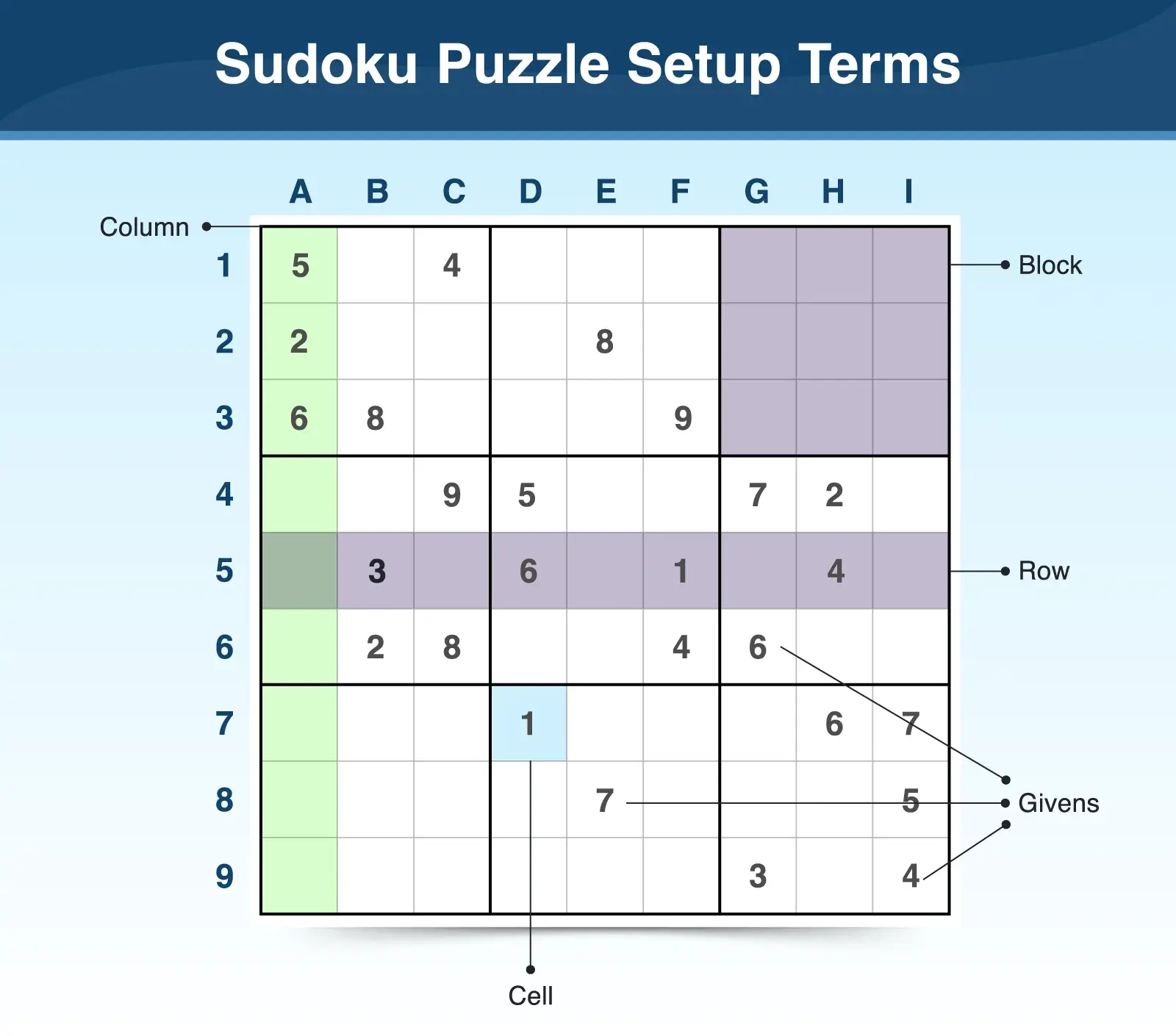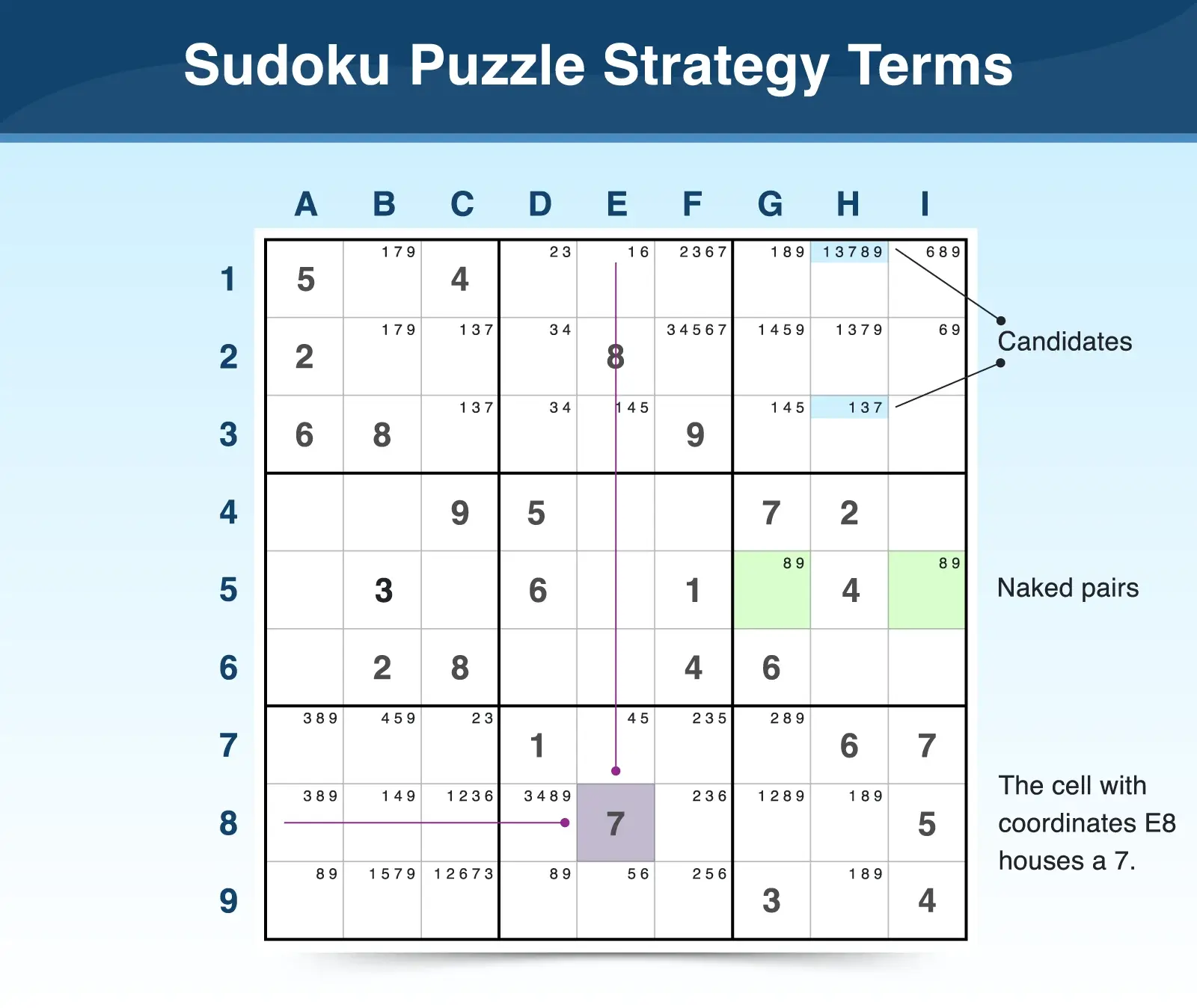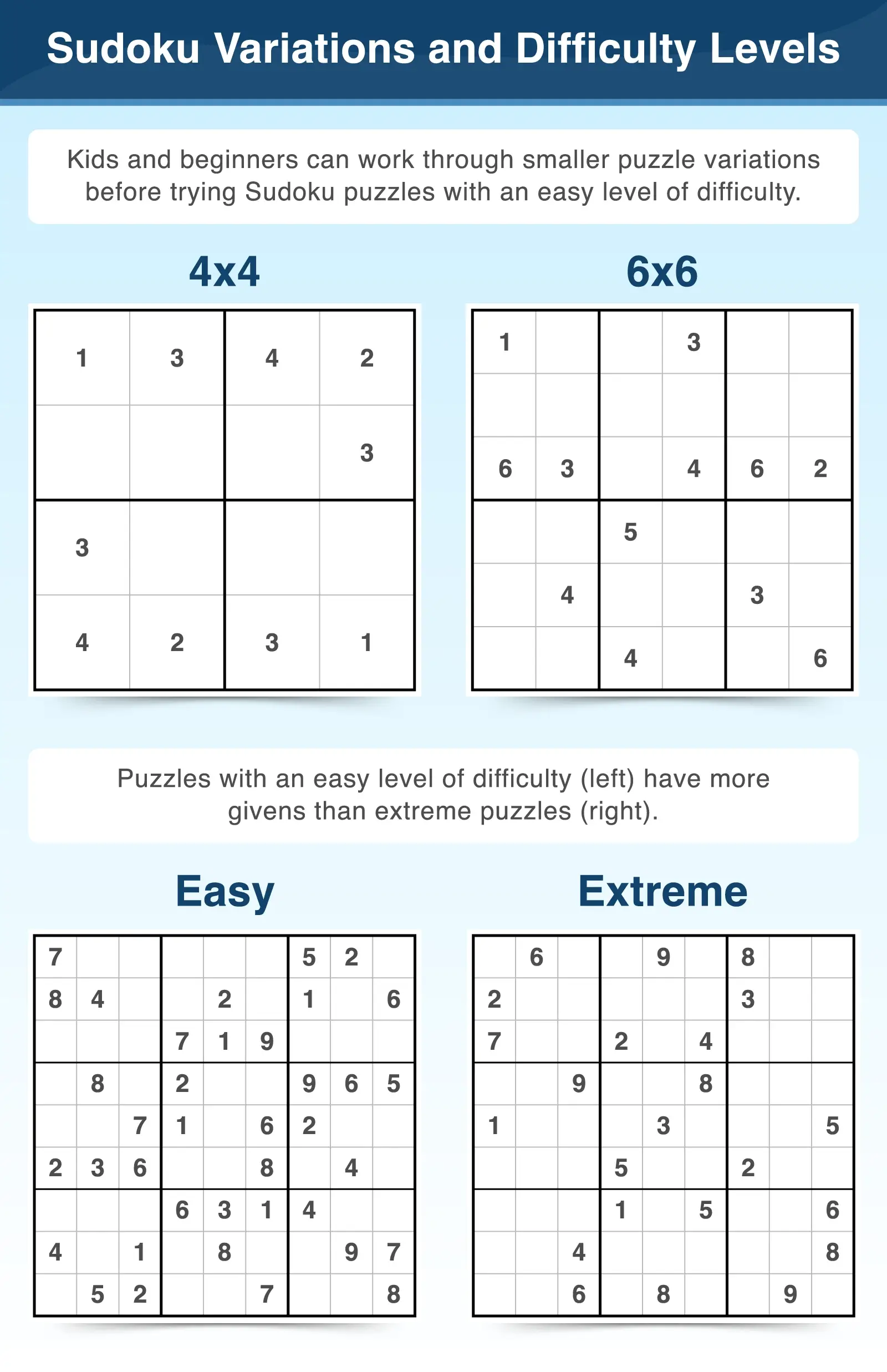Sudoku terminology may seem as cryptic as solving Sudoku puzzles, but if you know the terms, you not only understand how puzzles are set up but also how you strategically work through them to solve them.
In a standard Sudoku puzzle, you typically have nine columns and nine rows of cells arranged in a 9x9 grid. Within the 9x9 grid there are nine 3x3 square blocks. Each cell can have only one possible answer, using numbers 1 through 9, and a number cannot be repeated in a row, column, or block. Your goal is to solve the puzzle by finding the right number to place in each cell.
Use these terms to better understand Sudoku rules and strategy so you can play Sudoku and progress through different difficulty levels.
Sudoku Setup Terms
Puzzles are already set up when you solve them, but understanding the set up helps you better understand how the puzzle works. Typically, a Sudoku puzzle is a 9x9 grid, with groups of cells arranged in nine columns and nine rows. These terms help you understand all the components of this grid.

Block: A piece of the puzzle made up of nine adjacent cells set up in a 3x3 square; traditional puzzles have nine blocks (three rows and columns). Only one number, 1 through 9, can be placed in each cell of the block. No numbers can repeat within a block.
Cell: A single square in which only one number can be the answer; traditional puzzles have nine columns and nine rows with nine cells each for a total of 81 cells.
Column: Vertical line of nine cells; no numbers can repeat in a column.
Givens: A single digit already placed in a cell in the puzzle; use givens to deduce what numbers belong in other cells.
Grid: The entire Sudoku puzzle; in traditional puzzles, the grid is made up of nine rows and nine columns, all of which create nine boxes with nine cells each.
House: An entire row, cell, or block. See also, unit.
Row: Horizontal line of nine cells; no numbers can repeat in a row.
Unit: Used when referencing an entire row, cell, or block; this term is used in a lot of strategies when referring to all three elements of the grid. See also, house.
Solving and Strategy Terms
Every proper Sudoku puzzle has a unique solution, and by using solving techniques and a logical strategy, you can solve the puzzle efficiently. Get acquainted with these terms so you can decipher strategies easily.

Candidate: A possible number that may answer a single cell; also refers to a mode of play that allows for the marking of candidates. When you narrow down possible numbers that can answer a specific cell, you place a candidate in the corner for each possibility. As you continue through the puzzle, you will inevitably find answers to cells and can further eliminate candidates. See also, pencil marking.
Coordinates: A pair of numbers used to identify the location of a single cell. Different sites use different methods such as r#c#, but to make coordinates clearer, this site uses numbers for rows (rows 1 through 9) and letters for columns (columns A through I). So, for example, a cell in the second row and first column would be denoted as A2. Using coordinates is helpful when reading how to work a strategy. See also, notation.
Crosshatching: A basic technique great for beginners solving easy Sudoku puzzles, used to narrow down candidates or find the answer for a cell. Draw vertical and horizontal lines through columns and rows where a number already exists to eliminate cells where it can be placed. If you use crosshatching when solving a puzzle, you can quickly narrow down cells in which specific numbers could be candidates. So if you cross out all rows and columns with a 5, you will quickly discover cells where a 5 could be a candidate.
Hidden pair: When two cells within a house (row, column, or box) share two candidate numbers that no other cells in that house contain. For example, you discover one cell with a 4, 5, and 9 and another cell in the same row with a 3, 4, and 9. Scan that row and for other candidates that are 4s or 9s. If you don’t find any, then the 4 and 9 must be the only two possible answers for those two cells, and you can mark out the 5 and 3. Unlike naked pairs, where those two numbers are the only candidates in those two cells, hidden pairs are hidden with other candidates. However, since the hidden pairs only appear in those two cells, you can eliminate the other candidates from them.
Naked pairs: The only two candidates marked in two different cells in the same house that can answer those cells; no other candidates are marked in those two cells, which makes the two candidates obvious or naked. For example, if you write in candidates throughout a puzzle and then notice that one column has two cells with the same two candidates, 3 and 8, then the 3 and 8 are naked pairs and are the only two possible answers for those two cells.
Naked single: The only candidate that can solve the cell. After marking candidates, if a cell has just a single candidate in it, you’ve not only discovered a naked single but also the answer for that cell.
Nishio: A trial-and-error technique for solving puzzles that isn’t reliable or efficient and shouldn’t be used. In this technique, you find a cell that has two candidates and then guess which one is the answer. The trouble with this technique is that if you guess wrong, it leads to a cascade of wrong answers. Once you realize your mistake, you end up backtracking to correct several mistakes.
Notation: The method for describing the coordinates of the location of a cell; various methods are used by various sites and puzzlers, This site uses numerals for rows (1 through 9) and letters for columns (A through I). So if you are referring to the cell that is located in the fourth row and third column, the cell is C4. See also, coordinates.
Pairs: The same two candidates in two cells all within the same house.
Pencil marking: Marking candidates in the corners of cells; originates from using a pencil on puzzles printed on paper.
Quads: The same four candidates in four cells all within the same house.
Snyder notation: A solving technique where you make note of a candidate only if that candidate is a possibility in only two cells in a block; named after Thomas Snyder who is a famous Sudoku solver/puzzler and World Sudoku Champion. Those who use it find it more efficient than marking all the possible candidates.
Triplets (or triples): The same three candidates in three cells all within the same house.
X-wing: Helpful strategy for medium, hard, and evil Sudoku puzzles when trying to eliminate candidates to narrow down possibilities. Find two rows or columns where the candidate appears in exactly two cells. The four identified cells form a rectangle's corners. Since one cell in each row or column must contain the candidate, you can remove it as an option from other intersecting cells.
Terms for Sudoku Difficulty Levels and Variations
Sudoku grids come in different sizes, and puzzles are categorized into different levels of difficulty. So you can easily find a Sudoku variant to accommodate all ages and experience levels. And difficulty levels come in a wide range of challenges for anyone from the beginner to puzzling expert.
All sites or printed Sudoku puzzles may name levels differently, but this section details the Sudoku variations that you can generally find and how they are categorized on this site.

4x4 Sudoku: A very easy 4x4 Sudoku puzzle suitable for absolute beginners, such as children; the puzzle only has four rows and four columns.
6x6 Sudoku: A tiny step up from 4x4 Sudoku, a 6x6 Sudoku puzzle is also suitable for young beginners who have shown they can easily solve 4x4 puzzles. As the name suggests, it increases the number of cells you must manage since the puzzle is made of six rows and six columns.
16x16 Sudoku: An inherently more difficult puzzle, this puzzle is set up with 16 columns and 16 rows of cells. Because of its size, you must use letters A through G and numbers 1 through 9 to solve the puzzle. The even number of units in a 16x16 Sudoku puzzle makes it more difficult to find answers for cells when using solving strategies, so consider these to be in the Evil or Extreme category level.
Easy Sudoku: Puzzles of nine rows and nine columns with several givens filled in. These puzzles are best for beginners, especially if you’re already familiar with 4x4 and 6x6 Sudoku puzzles, but experts can use them to practice new solving techniques. Crosshatching is a common technique for solving these puzzles.
Evil Sudoku: A 9x9 puzzle with a high level of difficulty; few givens will be inserted, requiring you to use expert-level techniques to solve.
Extreme Sudoku: A 9x9 puzzle with an extreme level of difficulty. This puzzle will have the fewest number of givens, and expert-level techniques must be used to solve these. Best for Sudoku masters who can easily work Evil-level puzzles.
Hard Sudoku: A 9x9 puzzle with fewer givens than a Medium Sudoku puzzle. You’ll need to use even more techniques beyond what is used for Medium Sudoku puzzles, such as Y-wing and swordfish techniques.
Medium Sudoku: A 9x9 puzzle with fewer givens than an Easy Sudoku puzzle; you’ll have to use techniques, such as crosshatching and X-wing, to solve puzzles at this level.
Play Sudoku Today
The uniqueness of each Sudoku puzzle means you’ll always find an exciting challenge no matter your level of experience, and with Sudoku terminology at your fingertips, you can easily navigate puzzles and solving strategies. So discover the right level of difficulty and play Sudoku today!